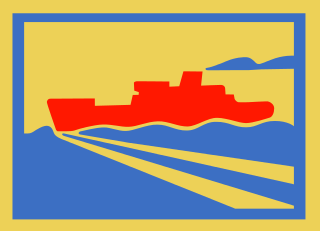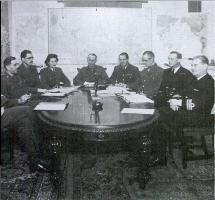
Operation Fortitude was a military deception operation by the Allied nations as part of Operation Bodyguard, an overall deception strategy during the buildup to the 1944 Normandy landings. Fortitude was divided into two subplans, North and South, and had the aim of misleading the German High Command as to the location of the invasion.

Operation Bodyguard was the code name for a World War II deception strategy employed by the Allied states before the 1944 invasion of northwest Europe. Bodyguard set out an overall stratagem for misleading the Oberkommando der Wehrmacht as to the time and place of the invasion. Planning for Bodyguard was started in 1943 by the London Controlling Section, a department of the war cabinet. They produced a draft strategy, referred to as Plan Jael, which was presented to leaders at the Tehran Conference in late November and, despite scepticism due to the failure of earlier deception strategy, approved on 6 December 1943.

The 55th Infantry Division was an infantry division of the British Army's Territorial Army (TA) that was formed in 1920 and existed through the Second World War, although it did not see combat. The division had originally been raised in 1908 as the West Lancashire Division, part of the British Army's Territorial Force (TF). It fought in the First World War, as the 55th Division, and demobilised following the fighting. In 1920, the 55th Division started to reform. It was stationed in the county of Lancashire throughout the 1920s and 1930s, and was under-funded and under-staffed. In the late 1930s, the division was reduced from three to two infantry brigades and gave up some artillery and other support units to become a motorised formation, the 55th Motor Division. This was part of a British Army doctrine change that was intended to increase battlefield mobility.

Fourteenth United States Army was a fictitious/military deception field army, under the command of John P. Lucas, developed under Operation Quicksilver as a part of the fictitious First United States Army Group.

Operation Ironside was a Second World War military deception undertaken by the Allies in 1944. It formed part of Operation Bodyguard, a broad strategic deception plan instigated by the Allies throughout the year to help cover the June 1944 invasion of Normandy. Ironside supported the overall deception by suggesting to the Germans that the Allies would subsequently land along the Bay of Biscay. It complemented efforts to deceive the Germans into believing that the Allies would also land in southern France at this time. Bordeaux was an important port for the German war effort and had already been a target of commando raids two years earlier. Ironside intended to play on German fears of an invasion in the region, with the aim of tying down defensive forces following Operation Overlord in June 1944.

Operation Zeppelin was a major military deception operation run by the British during the Second World War. It formed part of Operation Bodyguard, the cover plan for the invasion of Normandy in 1944, and was intended to mislead German intelligence as to the Allied invasion plans in the Mediterranean theatre that year. The operation was planned by 'A' Force and implemented by means of visual deception and misinformation.

The 76th Infantry Division was an infantry division of the British Army, which was formed in November 1941 and served during the Second World War. It was created when the Norfolk County Division, initially raised in 1940 to defend the Norfolk coast from a potential German invasion, was redesignated. The division maintained the defensive duties that had been assigned to it, prior to it being renamed, until late 1942 when it became a training formation. It was then responsible for providing final tactical and field training to soldiers who had already passed their initial training. After five additional weeks of training, the soldiers were posted to fighting formations overseas. The formation was used as a source of reinforcements for the 21st Army Group, that was fighting in the Normandy campaign. After all available British troops had left the United Kingdom for France, the division was disbanded in September 1944.

The 77th Infantry Division of the British Army was formed in 1941, during the Second World War, from the re-organisation of the Devon and Cornwall County Division. During its existence the division changed roles several times. The division's initial role was coastal defence, protecting Devon. On 20 December 1942, it was converted into a training formation, known as a reserve division. In this capacity, the division provided final tactical and field training for the infantry that had already passed their initial training. After five additional weeks of training, the soldiers would be posted to fighting formations overseas. The division also had a tank brigade attached to provide training in armoured warfare.

First United States Army Group was a fictitious Allied Army Group in World War II prior to D-Day, part of Operation Quicksilver, created to deceive the Germans about where the Allies would land in France. To attract Axis attention, prominent US general George S. Patton was placed in command of the fabricated formation.

The 61st Infantry Division was an infantry division of the British Army, raised in 1939 as part of the expansion of the Territorial Army in response to the German occupation of Czechoslovakia. The division was created as a duplicate of the 48th Infantry Division, and was assigned to home defence duties.

The 80th Infantry (Reserve) Division was an infantry division of the British Army formed at the beginning of 1943, during the Second World War. For the twenty months that the division existed, it was a training formation. It was made responsible for providing final tactical and field training to soldiers who had already passed their initial training. After five additional weeks of training, the soldiers would be posted to fighting formations overseas. Notably, the division was used as a source of reinforcements for the 21st Army Group, which was fighting in Normandy. After all available troops left the United Kingdom for France, the division was disbanded.

The London Controlling Section (LCS) was a British secret department established in September 1941, under Oliver Stanley, with a mandate to coordinate Allied strategic military deception during World War II. The LCS was formed within the Joint Planning Staff at the offices of the War Cabinet, which was presided over by Winston Churchill as Prime Minister.

The 11th Division, an infantry division of the United States Army, was activated twice during the First World War. During the Second World War the division was notionally reactivated as part of Fortitude South II.
Operation Cockade was a series of deception operations designed to alleviate German pressure on Allied operations in Sicily and on the Soviets on the Eastern Front by feinting various attacks into Western Europe during World War II. The Allies hoped to use Cockade to force the Luftwaffe into a massive air battle with the Royal Air Force and U.S. Eighth Air Force to give the Allies air superiority over Western Europe. Cockade involved three deception operations: Operation Starkey, Operation Wadham, and Operation Tindall. Operation Starkey was set to occur in early September, Operation Tindall in mid-September, and Operation Wadham in late September 1943.
Ops (B) was an Allied military deception planning department, based in the United Kingdom, during the Second World War. It was set up under Colonel Jervis-Read in April 1943 as a department of Chief of Staff to the Supreme Allied Commander (COSSAC), an operational planning department with a focus on western Europe. That year, Allied high command had decided that the main Allied thrust would be in southern Europe, and Ops (B) was tasked with tying down German forces on the west coast in general, and drawing out the Luftwaffe in particular.

The United States Army created a large number of notional deception formations that were used in a number of World War II deception operations. The most notable fictional US formation was the First U.S. Army Group (FUSAG); this field army was originally intended as the main invasion force for the Invasion of Normandy, however that was renamed to the 12th Army Group. FUSAG remained in existence on paper and was used during Operation Fortitude South to divert Axis attention to the Pas de Calais area.

Operation Ferdinand was a military deception employed by the Allies during the Second World War. It formed part of Operation Bodyguard, a major strategic deception intended to misdirect and confuse German high command about Allied invasion plans during 1944. Ferdinand consisted of strategic and tactical deceptions intended to draw attention away from the Operation Dragoon landing areas in southern France by threatening an invasion of Genoa in Italy. Planned by Eugene Sweeney in June and July 1944 and operated until early September, it has been described as "quite the most successful of 'A' Force's strategic deceptions". It helped the Allies achieve complete tactical surprise in their landings and pinned down German troops in the Genoa region until late July.





































